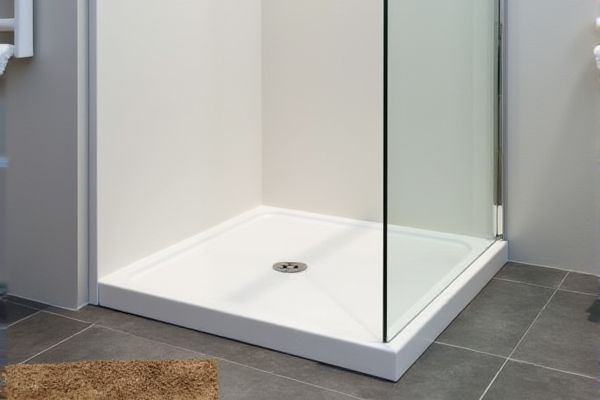
Threshold shower bases feature a raised edge to prevent water from spilling, making them easier to install and ideal for traditional bathroom designs. Curbless shower bases offer a seamless, accessible entry that enhances the modern aesthetic and improves safety by eliminating tripping hazards; explore the rest of the article to discover which option best suits Your bathroom needs.
Table of Comparison
| Feature | Threshold Shower Base | Curbless Shower Base |
|---|---|---|
| Design | Raised edge or curb at entry | Flush with bathroom floor |
| Accessibility | Less accessible for wheelchair users | Highly accessible and ADA compliant |
| Water Containment | Better water containment with curb | Requires precise waterproofing |
| Installation | Easier, standard installation | Complex, requires slope and drainage planning |
| Maintenance | Typical maintenance with curb | May need regular waterproofing checks |
| Aesthetics | Traditional look with curb | Modern, seamless bathroom design |
| Cost | Generally lower cost | Higher installation and material cost |
Introduction to Shower Bases: Threshold vs Curbless
A threshold shower base features a raised edge that effectively contains water within the shower area, making it ideal for traditional bathroom designs with existing drainage systems. Curbless shower bases offer a seamless, barrier-free entry creating a sleek, modern aesthetic perfect for accessible and minimalist bathrooms. Your choice depends on the desired bathroom style, ease of access, and water containment needs.
Design Differences Between Threshold and Curbless Shower Bases
Threshold shower bases feature a raised edge that contains water within the shower area, providing a clear physical barrier between wet and dry zones, while curbless shower bases are level with the bathroom floor, promoting seamless accessibility and a modern aesthetic. The design of threshold bases typically requires a step over the lip, which can affect ease of entry, whereas curbless bases eliminate this obstacle, enhancing usability for people with mobility challenges. Your choice between these designs will impact bathroom safety, water containment, and overall style.
Accessibility: Which Shower Base is More Inclusive?
Curbless shower bases offer superior accessibility by eliminating barriers, making them ideal for wheelchair users and individuals with limited mobility. Threshold shower bases, featuring a raised lip, can pose challenges for those requiring step-free entry. ADA-compliant designs favor curbless options to enhance safety and inclusivity in bathroom spaces.
Installation Process: Threshold vs Curbless
Threshold shower bases typically require raised framing and precise leveling to ensure proper drainage, making the installation process more structured and straightforward for standard bathroom remodels. Curbless shower bases demand meticulous waterproofing and floor slope adjustments to achieve seamless, barrier-free entry, often necessitating professional expertise and careful planning. Proper installation of curbless designs enhances accessibility and modern aesthetics but involves more complex subfloor preparation compared to threshold bases.
Space and Layout Considerations
Threshold shower bases require a raised edge that can limit the open space within a bathroom, potentially making smaller layouts feel more confined. Curbless shower bases offer a seamless, flush floor design that maximizes usable space and provides a smooth transition ideal for walk-in showers. In tight or minimalist bathroom designs, curbless bases enhance accessibility and create a more open, airy environment compared to the confined footprint of threshold bases.
Waterproofing and Drainage Comparison
A threshold shower base offers raised edges that enhance waterproofing by containing water within the shower area, reducing the risk of leaks and water damage. Curbless shower bases rely heavily on precise waterproofing techniques and sloped flooring to ensure effective drainage, preventing water from escaping into the bathroom. Your choice impacts drainage efficiency and waterproofing reliability, with threshold bases providing more built-in containment and curbless designs requiring meticulous installation for optimal water control.
Cost Analysis: Upfront and Long-term Expenses
Threshold shower bases generally have lower upfront costs due to simpler installation and standard materials, making them budget-friendly for initial projects. Curbless shower bases, while more expensive initially because of custom drainage and waterproofing requirements, offer long-term savings through easier maintenance and enhanced accessibility that can increase property value. Your choice should consider both immediate budget constraints and potential future expenses related to usability and upkeep.
Safety Features and Slip Resistance
Threshold shower bases typically include a raised edge that helps contain water, reducing the risk of slips caused by wet bathroom floors, and often feature textured surfaces to enhance slip resistance. Curbless shower bases provide a seamless entry, improving accessibility but require specialized slip-resistant materials and slope design to prevent water pooling and slips. Both designs prioritize safety through anti-slip coatings and proper drainage systems tailored to minimize accident risks in wet environments.
Aesthetic and Style Options
Threshold shower bases offer defined edges that create a classic, structured look suitable for traditional or transitional bathroom designs, with a variety of materials and finishes enhancing their visual appeal. Curbless shower bases provide a sleek, seamless transition between the shower and bathroom floor, promoting a minimalist aesthetic favored in modern and contemporary spaces. Both options can be customized with tiles, stones, or textured finishes, but curbless designs often emphasize clean lines and open space for a more integrated, spa-like atmosphere.
Maintenance and Durability of Shower Base Types
Threshold shower bases typically offer robust durability due to their raised edges, which help contain water and reduce leakage risks, making maintenance more straightforward by limiting water damage to surrounding areas. Curbless shower bases provide a sleek, seamless design that requires careful waterproofing and regular drainage checks to prevent water seepage, which can affect longevity if neglected. Your choice impacts maintenance efforts heavily; threshold bases demand less vigilance over water containment compared to curbless designs, which rely on precise installation and ongoing care to maintain durability.
 homyna.com
homyna.com